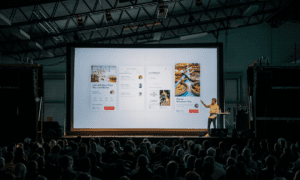Typography is often an overlooked element of branding, yet it plays a pivotal role in shaping how a company is perceived by its audience. From logos to marketing materials, the fonts and styles used can evoke emotions, communicate values, and leave lasting impressions. For businesses investing in visual marketing tools like banner printing in Calgary, understanding the influence of typography can make the difference between attracting attention and blending into the background.
Why Does Typography Matter in Branding?
Typography is more than just selecting fonts; it’s about creating a visual identity that resonates with your target audience. The typeface, size, spacing, and style all contribute to how information is processed and emotions are triggered. Effective typography can:
- Establish brand personality (e.g., modern, playful, professional)
- Build trust and credibility
- Improve readability and communication
- Create memorable experiences
In essence, typography transforms words into visual stories, making it a critical aspect of branding and marketing.
How Fonts Influence Emotions and Perceptions
Different fonts evoke distinct emotions and perceptions, influencing how people feel about a brand. Here are some common associations:
- Serif Fonts (e.g., Times New Roman): Traditional, reliable, and authoritative. These fonts are often used by banks, law firms, and established institutions.
- Sans-Serif Fonts (e.g., Helvetica): Modern, clean, and approachable. Popular among tech companies and startups for their simplicity and clarity.
- Script Fonts (e.g., Pacifico): Elegant, decorative, and personal. Ideal for brands in fashion, beauty, and luxury.
- Display Fonts (e.g., Impact): Bold, attention-grabbing, and creative. Suitable for headlines and promotional materials.
Choosing the right font aligns your visual identity with the emotions and values you want your audience to associate with your brand.
Typography and Readability: Finding the Right Balance
While aesthetics are important, readability should never be sacrificed. Typography must ensure that the message is clear and easy to consume. Factors influencing readability include:
- Font Size: Text that is too small can strain readers, while oversized text may appear unprofessional.
- Line Spacing: Proper spacing improves clarity and visual flow, reducing eye fatigue.
- Contrast: High contrast between text and background enhances visibility, especially in outdoor banners or signage.
In scenarios like banner printing, where the audience may only have seconds to absorb a message, readability becomes even more critical. Using bold headlines and simple fonts can make an impactful statement quickly.
Typography Trends in Modern Branding
Typography trends evolve with design preferences and technology. Businesses looking to stay current often incorporate modern typography techniques, such as:
- Minimalist Fonts: Clean, straightforward fonts emphasize simplicity and elegance.
- Variable Fonts: Dynamic fonts that adapt to different screen sizes, improving responsiveness.
- Retro and Vintage Styles: Nostalgic fonts that create a sense of familiarity and trust.
- Handwritten Fonts: Casual, friendly, and relatable styles that add a personal touch.
Staying ahead of trends can position your brand as modern and innovative, appealing to contemporary audiences.
Typography in Large-Scale Marketing Materials
When it comes to large-scale materials like banners, posters, and signage, typography takes on even greater significance. It must command attention from afar while maintaining clarity up close. Businesses utilizing banner printing in Calgary can benefit from strategic font selection to ensure their messages stand out.
Key considerations for large-scale typography include:
- Bold Fonts for Impact: Larger and thicker fonts are easier to read from a distance.
- Color Contrast: High-contrast designs grab attention and improve readability.
- Hierarchy and Emphasis: Using different font weights and sizes helps highlight key messages.
- Brand Consistency: Maintaining font styles across materials reinforces brand identity.
By aligning typography with design goals, businesses can maximize the effectiveness of their marketing campaigns.
Conclusion: Typography as a Branding Tool
Typography is more than a design choice—it’s a powerful tool for building brand perception. From evoking emotions to enhancing readability, the fonts you choose have a direct impact on how your business is perceived. Whether designing logos, marketing brochures, or large-scale signage, thoughtful typography decisions can set your brand apart.
For businesses looking to create impactful visual materials, professional banner printing in Calgary offers a canvas to showcase branding through strategic typography. With the right approach, you can turn words into visual assets that captivate audiences and leave a lasting impression.

































